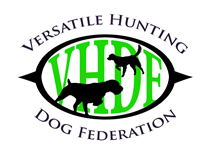The VHDF scoring system is referred to as a 10 point plus system. Under relatively normal conditions, dogs are scored from 0 to 10 in each subject, with a 10 being roughly equal to a 100 percent performance. A 100 percent performance means that nothing else is expected at that level in that subject and there is little to no room for improvement. Likewise, a 5 is roughly equal to a 50 percent performance, meaning the dog did half of the work expected or showed half of the ability that experience tells us is possible. The scores of 11 and 12 are reserved for performances that exceed the expectations of the judges, and in the case of the 12 overcame difficult conditions as well. Every dog that runs does not necessarily have the opportunity to score an 11 or 12. Some of the scoring is dependent upon the grounds and the conditions, but the system does recognize and record exceptional performances when they occur. All dogs at all times have the opportunity to earn a 10. However, not all dogs are capable of earning a 10 in every subject. A 10 means that there was likely no room for improvement in the performance. A score of 8 should be considered quite good. Indeed, the scores of 6, 7 and 8 fall in the "good" category, while 9 and 10 fall in the "very good" category. The VHDF scoring system is designed to leave plenty of room at the top end to recognize truly exceptional dogs and performance when they occur. In many venues, an average dog can earn the highest possible score. If most or even many dogs receive all 10's then our system of identifying above average individuals is useless; consequently, we would have a system that is useful at identifying below average individuals only.
In the Hunting Aptitude Evaluation, all subjects are scored with a numerical weighting factor of one. This is for simplicity so that individuals and breed clubs may easily interpret the numbers for their own purposes. While we as individuals may value certain characteristics more than others, i.e. some say desire is more important than cooperation, we have refrained from placing arbitrary numerical weighting factors on the individual subjects. After all, if a dog is deficient in any one of the inherited aptitudes considered to be useful for versatile hunting dogs, he is not a good prospect as a truly versatile hunting companion.
In the Advanced Aptitude Evaluation and in the Performance Evaluation where more training is required we have divided the scoring into trained subjects and natural ability subjects. The trained subjects have a numerical weighting factor of one while the natural ability subjects have a numerical weighting factor of two. Training tends to have more variables than aptitude and therefore less genetic importance, but it should not be overlooked entirely. More details on scoring the individual subjects in each level of testing is available in the Test Rules section of this website.
Ultimately, the purpose of the VHDF 10 point plus system is to provide meaningful and consistent information to breeders, groups of breeders, and breed clubs. The Versatile Hunting Dog Federation does not award first, second, and third place; nor prizes; nor trophies and ribbons. VHDF seeks to provide information that individuals as well as groups may use as they see fit for their particular situation. The level of detail provided by the 10 point system allows breeders to increase the selection pressure for particular traits that they seek, as well as for the overall quality of their breed. For example, while we would consider a dog that earned all 8's a potentially useful breeder, dogs and especially lines of dogs or litters of dogs that consistently score 10's and 11's certainly show the genetic value of their parents. These individual dogs may also be able to pass on desirable traits to improve other lines of dogs locally or nationally. Further, the consistency and detail of the VHDF scoring system permits breeders who are separated by long distances to: (a) become aware of the existence of such dogs, (b) to understand their talents and abilities with some surety, and (c) possibly eliminate the need to view them work in person.

